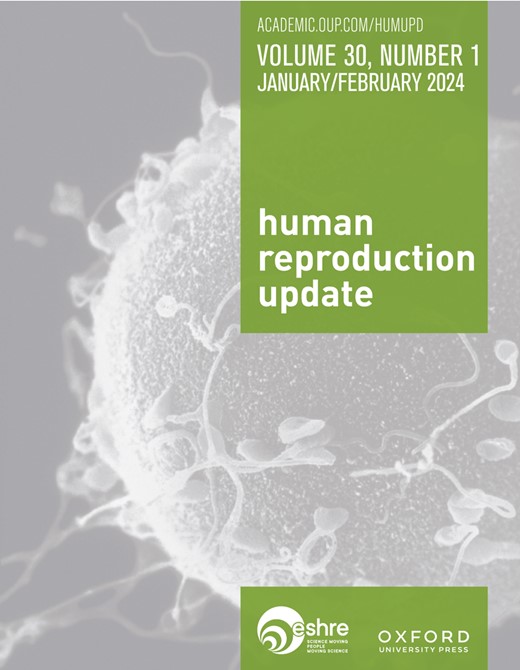试管受精和人类进化。
IF 14.8
1区 医学
Q1 OBSTETRICS & GYNECOLOGY
引用次数: 2
摘要
和所有物种一样,人类也是通过自然选择进化而形成的。虽然进化是所有生物过程的核心,但竞争和选择的关键阶段是繁殖,包括从求偶、交配到受精和怀孕的各种事件。在人类中,试管婴儿被用来帮助本质上效率低下的交配繁殖,在一些国家,试管婴儿后出生的儿童比例正在增加。虽然体外受精是不育患者的一项使能技术,但它也绕过了生殖障碍,改变了选择压力。这篇宏大的主题综述描述了体外受精和交配在生殖细胞、个体和群体的选择压力方面的系统差异。例如,在选择的细胞单位上,试管受精更倾向于精子的不同特征(短距离游得快)而不是性交(长距离向前移动)。同样,精子质量较低的男性和决定将第一胎推迟到高龄的女性,都可以通过试管受精来提高其生殖健康,而不是通过性交来繁殖。由于延迟生育是一种文化特征,因此试管受精使文化实践可能反过来影响人类进化。本综述的重点是讨论体外受精背景下生物和文化特征的相互作用,以及它们如何共同推动体外受精需求的增加。这篇综述的目的不是反对试管婴儿,这无疑是一项重大的医学进步,而是从一个广泛的角度来审视试管婴儿和人类进化,包括潜在的长期影响。由于体外受精是一项年轻的技术,表明体外受精对人类进化影响的经验数据很少。总的来说,我们认为体外受精促进了人类生殖资源的重新定向,因为体外受精的生殖绕过了交配生殖所需要的一些资源需求过程。因此,体外受精为人类物种越来越依赖和适应技术生殖手段奠定了进化的基础。本文章由计算机程序翻译,如有差异,请以英文原文为准。
IVF and human evolution.
Humans are shaped by evolution through natural selection, as are all species. While evolution is central to all biological processes, the key stage for competition and selection is reproduction, which encompasses various events from courtship and mating to fertilization and pregnancy. In humans, IVF is used to aid the intrinsically inefficient reproduction by coitus, and in several countries, the proportion of children born after IVF is increasing. While IVF is an enabling technology for infertile patients, it also circumvents reproductive barriers and changes selection pressures. This grand theme review describes the systematic differences between IVF and coitus in selection pressures on reproducing cells, individuals and populations. At the cellular unit of selection, for example, IVF favours different traits in spermatozoa (fast swimmers over short distances) than coitus does (forward mobility over longer distances). Similarly, a male with low sperm quality and a female who decides to delay her first birth to an advanced age, can both increase their reproductive fitness by IVF compared to if reproduction by coitus is their only option. In as much as delayed reproduction is a cultural trait, IVF thus enables cultural practices that may in their turn affect human evolution. A main point in this review is to discuss the interactive effects of biological and cultural traits in the context of IVF, and how they act in concert as drivers towards increased demand for IVF. It is not the aim of this review to argue against IVF, which no doubt is a major medical advancement, but rather to examine IVF and human evolution from a broad perspective, including potential longer-term impacts. Since IVF is a young technology, the empirical data indicative of evolutionary effects of IVF in humans are sparse. In general, we argue that IVF facilitates the redirection of resources away from reproduction in humans, since reproduction by IVF bypasses some of the resource-demanding processes that reproduction by coitus entails. Hence, IVF sets the evolutionary stage for a human species increasingly reliant on, and adapted to, technological means of reproduction.
求助全文
通过发布文献求助,成功后即可免费获取论文全文。
去求助
来源期刊

Human Reproduction Update
医学-妇产科学
CiteScore
28.80
自引率
1.50%
发文量
38
期刊介绍:
Human Reproduction Update is the leading journal in its field, boasting a Journal Impact FactorTM of 13.3 and ranked first in Obstetrics & Gynecology and Reproductive Biology (Source: Journal Citation ReportsTM from Clarivate, 2023). It specializes in publishing comprehensive and systematic review articles covering various aspects of human reproductive physiology and medicine.
The journal prioritizes basic, transitional, and clinical topics related to reproduction, encompassing areas such as andrology, embryology, infertility, gynaecology, pregnancy, reproductive endocrinology, reproductive epidemiology, reproductive genetics, reproductive immunology, and reproductive oncology. Human Reproduction Update is published on behalf of the European Society of Human Reproduction and Embryology (ESHRE), maintaining the highest scientific and editorial standards.
 求助内容:
求助内容: 应助结果提醒方式:
应助结果提醒方式:


